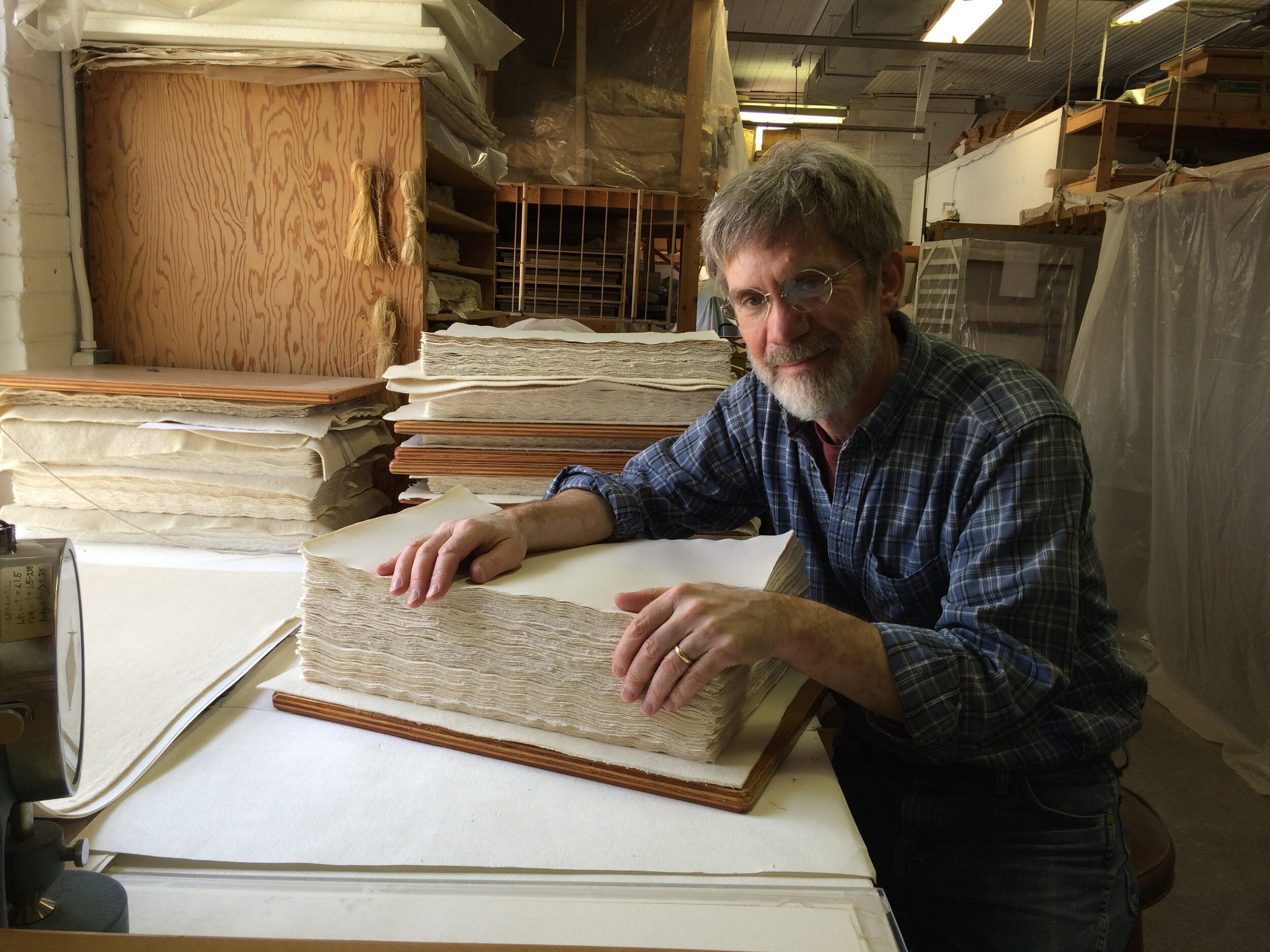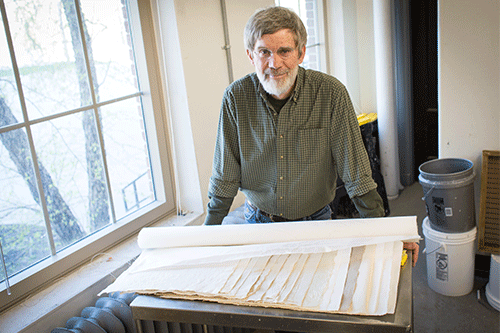
TIM BARRETT
PAPERMAKING CHAMPION
Barrett has helped to bring alive the art of papermaking, to bring attention to it as something more than producing a surface to write on, but that the paper and the process itself has a beauty all its own.
Tim Barrett
Papermaking Champion
Tim Barrett—a highly respected master craftsman, leading practitioner, scholar, innovator and teacher of hand papermaking—has an impressive life and career story to share, one which began with humble roots in the Midwest and grew to international impact and prominence. For more than 20 years, I have followed his work and the impact of his work on others—former students and collaborators. I first met Tim in 2000, when I co-curated the exhibition, Making Waves in the Midwest: The Art of Asian Paper, which included Barrett’s work as well as many of his former students. It is rare for someone to have a high aptitude for very technical and historical research and to approach the subject, in this case a material—paper—with the awe of an artist craftsman, highly sensitive to the creative and expressive potential of the material. Barrett has exercised this in both his research and writing, teaching, and own work. I would venture that many of the most talented paper conservators, book artists, and artists who primarily rely on paper as the major material in their two- or three-dimensional work, have studied with Barrett, or benefited from those who have studied with him.
An autodidactic in the history and science of papermaking, Barrett is the founding director and visionary behind the Papermaking Facilities at the University of Iowa’s Center for the Book. Since 1986, when he created the facility and launched a teaching program, he established the only facility in the country where both Western and Japanese-style paper is handmade. His program has attracted traditional and non-traditional students from around the world, of all ages, from different disciplines, and with varying objectives. The Center’s reputation as one of the leading places in the country to study hand papermaking is due to Barrett’s ability to synthesize tradition and innovation, to consider both the symbolic and expressive characteristics of paper as well as functionality. He, and his program, have attracted artists, bookmakers, paper conservators and writers from around the world to work at the Center, specifically with Barrett in both a spirit of collaboration and for formal training. Many learn to make or appropriate handmade paper for their own work—whether book artists or printmakers, conservators or artists. The Center has financially struggled for years to sustain itself within the larger Center for the Book Arts and the University, raising some of its operational funds through the sales of handmade papers produced at their facilities, receiving orders from artists and conservators around the world.
Barrett’s accomplishments are all the more impressive when one considers it has not been an easy road. The artistry of papermaking often falls between the gaps in traditional museum art collections and university art departments. A visionary with many practical talents, Barrett inspires and mobilizes others to consider the many untapped, expressive and functional potential uses of handmade paper, even in the face of rapid technological developments. Aside from his own work, he is renowned as a tremendous collaborator. He has worked on all kinds of conservation, book arts, and even medical projects with all kinds of other creative individuals—scientists, conservators, poets, archivists, and even the medical doctors. Barrett has taught, researched, and worked all over the world, inviting both low and high-tech experimentation, introducing ways for hand papermaking to be a viable craft in this country, through the study of it in other countries, while simultaneously fostering exchange—many of his students have spent years in other countries mastering hand papermaking techniques and bringing them to the U.S. His vision and belief in the humanity and simply beauty connected with this craft has brought about many unexpected projects and results, in places as far reaching such as Africa and Tibet. His research and knowledge of the archival issues of paper made him the choice consultant and source for the handmade archival paper used to re-house the Declaration for Independence, Bill of Rights, the Constitution as part of the “Charters of Freedom Paper Project” in 2002.
In 2009, Barrett received the coveted and highly competitive MacArthur Genius Award that comes with a generous cash prize to reward creative individuals and their work, whose impact on the arts and the world at large has been far reaching and diverse. This is clearly the case of Tim Barrett, who is known to still bring tears to the eyes of many when he talks about his passion for the art and science of papermaking. And what did he do with his award funds? He invested it into his University of Iowa research and special projects, so as not to just benefit his work but the university and papermaking field at large. Barrett has taken hand papermaking beyond the traditional boundaries of graphic arts or books arts classes. Barrett has helped to bring alive the art of papermaking, to bring attention to it as something more than producing a surface to write on, but that the paper and the process itself has a beauty all its own. He has worked innumerable hours, given his time to students and his work, because it is about a passion and vision for the material and the field.
—Jane Milosch
Honorary Professor, School of Culture & Creative Arts, Glasgow University
Former Curator, Renwick Gallery, Smithsonian American Art Museum, and Founding Director, Smithsonian Provenance Research Initiative






Become an NAHP Member
Join our vibrant hand papermaking community and access your membership benefits.










